This post may contain affiliate links. You can read my affiliate policy here.
Do you want to move better without it taking up any extra time? Do you want to work all your small muscles in your feet and legs, have better posture, less strain on your joints, and even improve your pelvic floor? Then move away from your traditional hiking boots and go hiking in barefoot shoes or boots!
This beginners guide will take you through the concept of barefoot shoes, the benefits and risks, why hiking in barefoot shoes is the perfect start for any beginner transitioning into minimal footwear, and how to make this transition safely and comfortably.
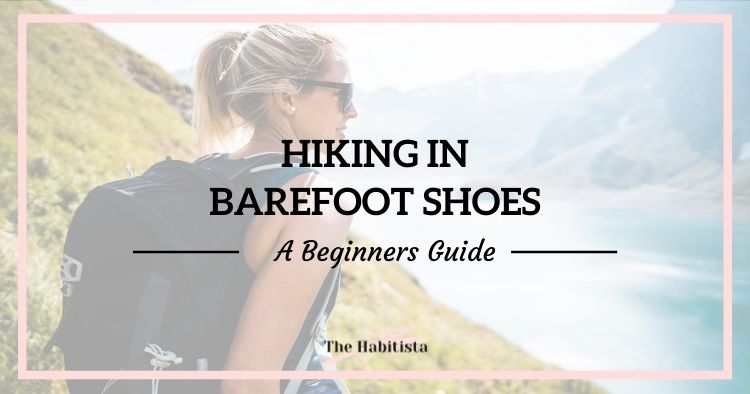
What are Barefoot Shoes?
Barefoot, or minimalist shoes as they are also called, are shoes that allow you to experience the ground you are walking on as closely as possible to what it would feel like if you really were barefoot, while still protecting your feet.
There are 6 key features of barefoot shoes to be aware of:
Barefoot Shoes are Flat
In normal shoes, the heel is higher than the toes. This is not only true in what we consider high heel shoes but even trainers and so-called flat shoes has some kind of padding or heel that makes the heel come up from the ground. (Running shoes often have the heel around 1cm above the toes).
Barefoot shoes on the other hand are completely flat. There is no incline or padding for the heel. It is (as if) you were going barefoot with your heel and your toes hitting the ground on the same level.
Barefoot Shoes have a Thin Sole
A pair of barefoot shoes have only as much sole that is needed to protect your feet and nothing more. There is no padding, and the soles are very flexible, enabling you to feel the ground and to move your feet with the ground, instead of having a rigid and cushioned sole that is made for you not to feel the ground.
Toe Space in Barefoot Shoes
Some people associate barefoot shoes with shoes with toes, that looks more like a ‘foot glove’ than a shoe. That is one way to do barefoot shoes, however most barefoot shoes today prefer to give you a wide toe box instead of individual toes.
This means that your shoes will look much more like normal shoes but there will be plenty of space for your toes to move and spread out, as they would do if you were walking barefoot.
Lightweight and Flexible
Because the purpose of barefoot shoes is to mimic actually being barefoot, while still protecting your feet, they will be the most lightweight and flexible shoes available.
Padding
There is no padding in barefoot shoes as they encourage you to use the muscles in your feet in the way you do when you walk or hike barefoot. We have already mentioned that there will be no cushion under the heel or toe, and you won’t find arch support or any other kind of padding either.
Barefoot Shoes are Secure on Your Foot
There is no effort required to keep barefoot shoes securely on your feet. No toe squeezing or technique required to get them to stay on. They are securely fastened on your feet so that you can move naturally.
Benefits of Hiking in Barefoot Shoes
The main benefit of hiking in barefoot shoes is that you are able to walk in nature in the way humans have done for the most part of our evolution. And this, while still providing protection from the weather and any nasty sharp things you happen to step on.
8 Benefits of Hiking in Barefoot Shoes:
- Work your muscles. By walking without the cushion and support of normal shoes you strengthen the 29 muscles associated with the foot.
- Improved arch support. When your muscles in your feet develops you will get built in arch support and not be dependent on shoes to provide it for you.
- Better posture. By developing healthy muscles associated with the feet your posture will improve. Spinal posture is further helped by not having to compensate for the body being pushed forward by a heel.
- Better gait. The way you walk will improve as you develop the muscles associated with the feet and with how you walk.
- Less strain on joints. By improving your muscles, posture and the way you walk, you will decrease the strain on your joints, especially knees, hips and shoulders.
- Increased feeling in your foot. We were made to feel what we are walking on to be able to react appropriately. When we start using the muscles in our foot more, we also increase our nerve health.
- Improved pelvic floor. This one might be a surprise but by having your ancle in neutral the activity in your pelvic floor will significantly increase. If you want to protect your pelvic floor but don’t seem to remember to do your exercises, hiking in barefoot shoes might be the answer!
- Less stress. There are studies indicating that barefoot walking may reduce stress. Think about how you feel after a foot massage. When you hike barefoot, nature itself will be providing the massage helping you lower your cortisol and de-stress.
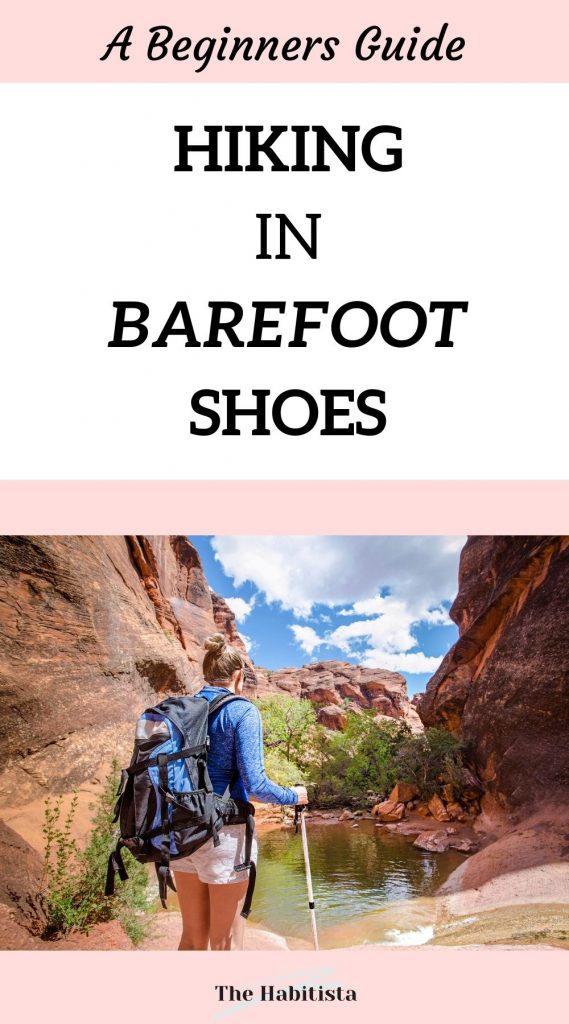
What are the Risks of Hiking in Barefoot Shoes?
The biggest risks in using barefoot shoes comes in the transition. To do too much too quickly, without giving the muscles in your feet a chance to develop to protect your feet. The most risks (and also the most studied risks in the scientific community) comes from running barefoot.
Using barefoot shoes for running without having first built up the muscle length and strength required does come with significant risks, especially running on asphalt which is in itself a very hard material.
This is why I recommend starting your barefoot journey by hiking. To walk, not run, and to do so on natural materials where you will get more of the benefits and less of the risks.
Risks of Hiking in Barefoot Shoes:
- Increased risk of Achilles injury. If you have walked a lot in normal or high heeled shoes, your Achilles and calf are likely short and a quick transition to barefoot shoes can increase the risk of Achilles injuries.
- Tired feet. If you are not used to using the muscles in your feet they will tire quickly! Remember that doing too much too quickly will leave your feet tired, just as when you work any muscle that’s not normally used.
- Heel pain. You need to change (improve) your gait, the way that you walk, when using barefoot shoes. If you tend to hit the ground very hard with your heel this can cause pain in your heel, and possibly in other parts of your body as you compensate for the pain in your heel bone.
Start Hiking Barefoot
Are you sold on the benefits? You want to give barefoot shoes a go? Great, let’s get started!
As we have discussed, barefoot hiking is a great introduction to using barefoot shoes as it’s less impactful than running. In addition, it is usually done on natural ground rather than paved paths. However, to transition safely to barefoot shoes there is some preparation to do. And the first steps don’t even require you to buy a pair of barefoot shoes!!
Walk Barefoot Indoors
If you use shoes indoors, especially if they usually have high heels, you may want to start just taking your shoes off at home for short periods of time to see how it feels. Can you walk comfortably barefoot, or do you find you start walking on your tippy toes? Does it feel uncomfortable in your achilles?
If you do, you probably have short calf muscles, and you will want to lengthen them before transitioning to barefoot shoes to avoid injuries.
Exercises and Stretches
There are several stretches and exercises that can help you prepare for your transition to barefoot shoes. These will help activate and stretch the muscles in your feet and elsewhere that are normally underutilized.
Calf Stretch
Short calves are one of the main obstacles to hiking in barefoot shoes, luckily you can easily fix that by stretching your calves.
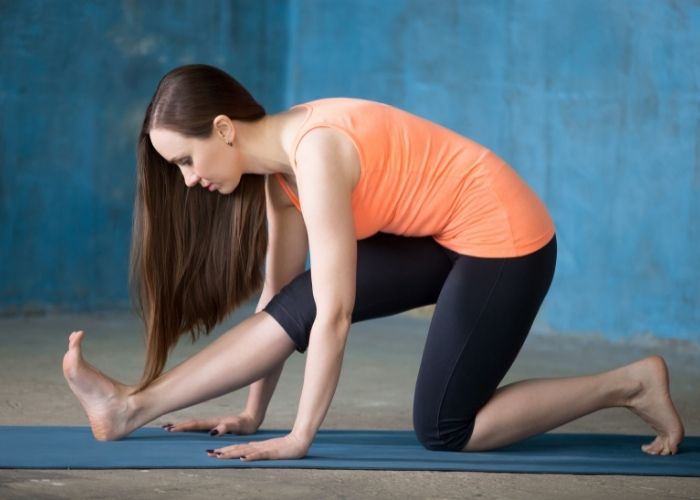
Calf Raise
Strengthening your calf’s will also help. Raise up on your toas as often as you can – for extra bonus, do it on the stairs so you can really let your heels drop in between lifts.
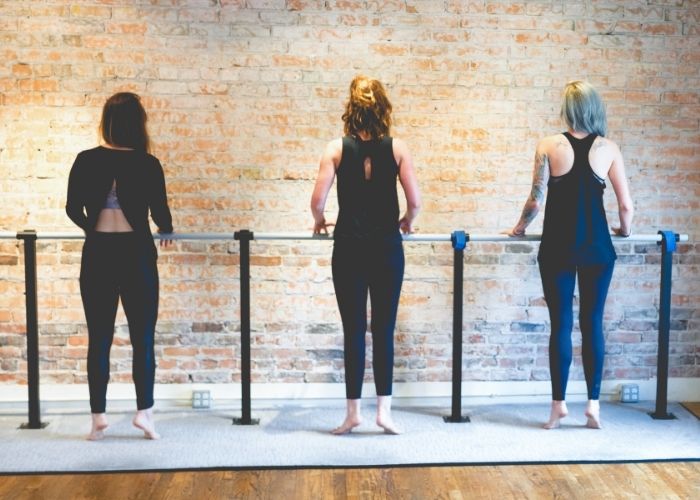
Foot Massage
Wake up your muscles and nerves by massaging your foot with a spiky ball, standing on a stone mat, or walking barefoot in your garden.
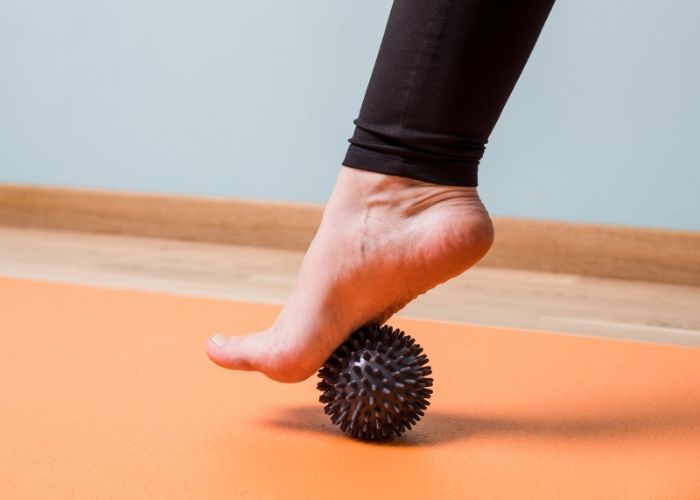
Toe Spacer Stretch
If your toes have been squashed together in narrow shoes for many years, they may need some help to start spreading out. Use a toe spacer to help them along. Just a few minutes will make a big difference!
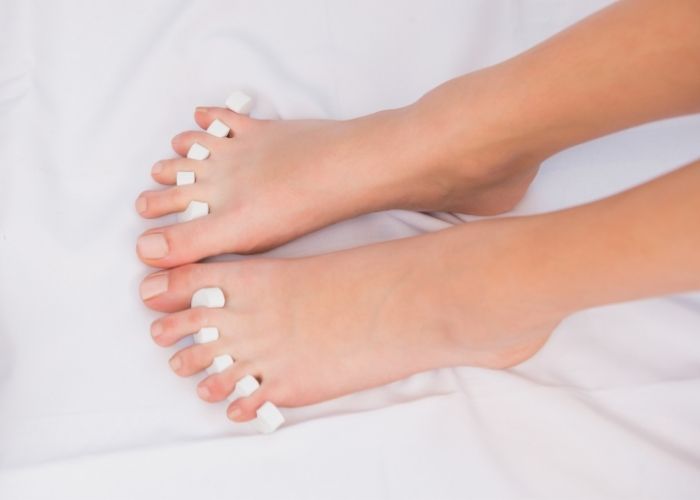
Buying Barefoot Shoes for Hiking
Ok, when your feet feel ready it’s time to actually buy those shoes! There are many different brands of barefoot and minimalist shoes. My favourite brand is Vivo Barefoot as they are both comfortable and stylish as well as being a company that’s mindful about its impact on the environment.
Things to consider when buying barefoot shoes for hiking:
- Sole. You will want a thin sole so you can feel the ground, but you also want there to be enough grip so not to be slippery.
- Ancle support. Most barefoot shoes do not come with ancle support, but if you are hiking, especially if your hiking is on uneven ground you may still want to consider a boot rather than a shoe to help protect from injuries.
- Waterproof. You will most likely want to avoid mesh shoes and instead buy something water resistant or waterproof.
- Return policy. Barefoot shoes can be differently sized to normal shoes, especially in regard to the wider toe box. If you can’t try them on in a store, make sure you use a company with an excellent return policy (like Vivo Barefoot).
- Aesthetics. You still want to feel good in your shoes! There are plenty of good-looking barefoot shoes so chose a pair you would feel good wearing.
The hiking boots I use are Vivo Barefoot’s Tracker II FG. They are waterproof, have a great grip but still come with that great barefoot feeling.
Read More: Best VivoBarefoot Shoes for Women: Review After 1 Year of Use
Time to Start Walking
It is finally time to put on your new barefoot shoes and go for a walk!
Start small. A walk around the block may be sufficient to start with. And if you can, try to find a patch of grass or other natural ground to walk on rather than the pavement as this will help reducing the risk of injury.
Slowly build up by walking longer and in different types of terrain. Feel your calf stretch as you walk up a hill without a raised heel. Feel the uneven ground under your feet. Try walking on grass, rocks and gravel and feel how the use of your muscles differs.
Take longer and longer walks, building up to when you can go on long hikes with your barefoot shoes. This is when the magic really comes! You will experience the hike more when you feel the ground underneath your feet. The better posture, the increased streangth and balance, will all feed into the experience of your hike.
You will start getting more and more of the benefits of barefoot hiking the more you do it, and once you do, you may consider switching to barefoot shoes in other parts of your life. For running, socialising, or working. But only take this next step once you are really comfortable hiking in your barefoot shoes. You will know when it’s time because that’s the day that putting on your normal shoes feels weird and uncomfortable. When you no longer want to compensate for a raised heel and you miss not feeling the ground under your feet.
Congratulations, you are now a person who walks in barefoot shoes!
Read More
Your Health is a Priority: A Complete Guide to a Healthy Life
Habits to Improve Your Life: The Ultimate Guide
10 Health Benefits of a Daily Morning Walk

Leave a Reply